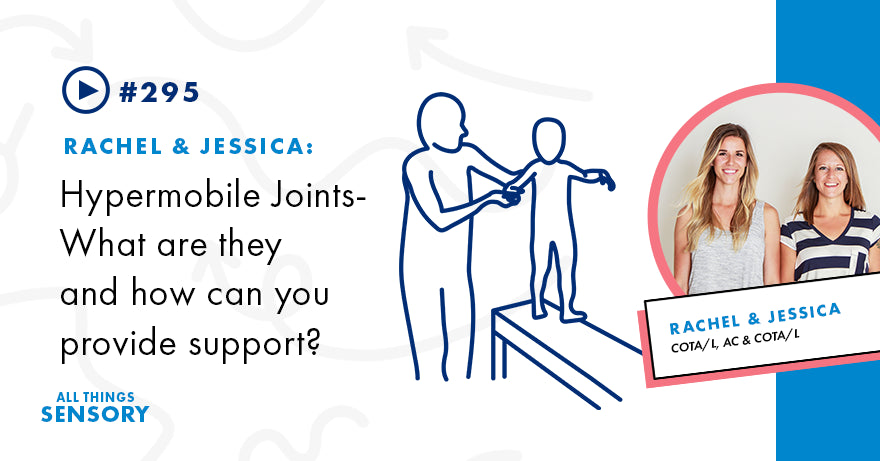Your Cart is Empty

What are hypermobile joints? Who can they affect? What are the functional implications?
We dive into these questions, the research, and some information that will be helpful if your child or your clients have hypermobile joints. We also talk about some of the challenges that can be associated with hypermobility.
Things like strength training, swimming, nutrition, and finding the right footwear are just a few of the strategies we talk about.
Make sure to check out all of our links below!
We’d love to answer your questions on the podcast! Fill out this form -> https://harkla.typeform.com/to/ItWxQNP3
All Things Sensory Podcast Instagram
Harkla Website - Shop Sensory Products!
Muscle Tone vs. Muscle Strength
Prevalence of Joint Hypermobility in Children
Recently, a parent who is also a member of our customer service team raised a question regarding her child's hypermobile joints and whether there is a link to primitive reflexes. It sparked an interest in understanding hypermobility and how it can impact a child's development.
Hypermobility is characterized by an extensively wide range of joint motion, which may or may not be accompanied by noticeable symptoms. While some individuals with hypermobile joints experience no adverse effects, others may suffer from pain, discomfort, and an elevated risk of injuries.
This condition is most commonly found in young children and tends to decrease with age. However, it can also persist into adulthood and potentially last a lifetime. A combination of factors, including genetics, connective tissue disorders, and repetitive physical activities, can influence the onset of hypermobility.
Studies focusing on school-aged children reveal that 30% to 50% are affected by hypermobility. Younger children's fast-paced growth and development require increased joint mobility to accommodate their rapid physical transformations.
However, when individuals reach adulthood and achieve full physical maturity, the necessity for extensive joint mobility decreases. Typically, hypermobility does not necessitate medical treatment, as it frequently exhibits no symptoms.
Research indicates a correlation between hypermobility and various chronic conditions among certain children, including pain, musculoskeletal complications, and developmental coordination delays. Notably, a significant link exists between joint hypermobility and Developmental Coordination Disorder.
Understanding the root cause is critical, especially because increased joint laxity heightens the risk of injuries, such as sprains and dislocations. This relates to the effects of hypermobility on health, which may encompass:
Some studies suggest a correlation between hypermobility and retained primitive reflexes. These reflexes are typically present during infancy and should become integrated as the child grows. However, in individuals with hypermobile joints, they may persist into childhood and adulthood.
Retained primitive reflexes can impact motor skills, coordination, and balance, which are already affected by hypermobility. This further highlights the need for proper support and management of both conditions to promote optimal development and functioning.
Should you or your child possess hypermobile joints, multiple strategies exist to offer support and effectively manage this condition:
Occupational therapy (OT) is a crucial resource for those managing hypermobility. It guides individuals in the correct utilization of their joints and muscles to achieve peak performance. Moreover, OT assists in overcoming any developmental or motor challenges associated with hypermobility, including issues with fine motor skills or balance.
It utilizes specific strategies, such as:
Managing hypermobile joints can be challenging, yet individuals affected by this condition can enjoy active and fulfilling lives with proper support and care. Consulting a medical professional for tailored advice and treatment options is crucial.
With the proper management and support, individuals experiencing hypermobility can excel and realize their utmost potential. Thus, it becomes crucial to amplify awareness regarding this condition and champion enhanced care and resources for those impacted.
BORING, BUT NECESSARY LEGAL DISCLAIMERS
While we make every effort to share correct information, we are still learning. We will double check all of our facts but realize that medicine is a constantly changing science and art. One doctor / therapist may have a different way of doing things from another. We are simply presenting our views and opinions on how to address common sensory challenges, health related difficulties and what we have found to be beneficial that will be as evidenced based as possible. By listening to this podcast, you agree not to use this podcast as medical advice to treat any medical condition in either yourself or your children. Consult your child’s pediatrician/ therapist for any medical issues that he or she may be having. This entire disclaimer also applies to any guests or contributors to the podcast. Under no circumstances shall Rachel Harrington, Harkla, Jessica Hill, or any guests or contributors to the podcast, as well as any employees, associates, or affiliates of Harkla, be responsible for damages arising from use of the podcast.
Keep in mind that we may receive commissions when you click our links and make purchases. However, this does not impact our reviews and comparisons. We try our best to keep things fair and balanced, in order to help you make the best choice for you.
This podcast should not be used in any legal capacity whatsoever, including but not limited to establishing “standard of care” in a legal sense or as a basis for expert witness testimony. No guarantee is given regarding the accuracy of any statements or opinions made on the podcast.
Comments will be approved before showing up.